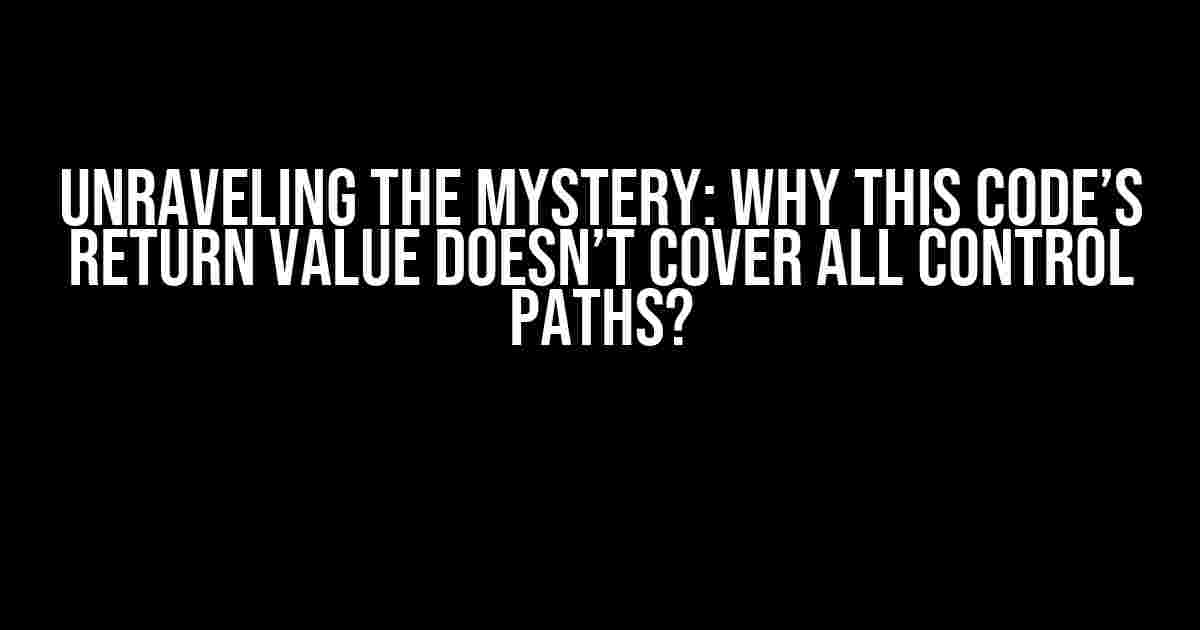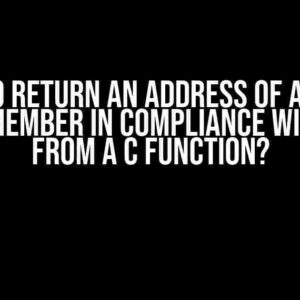Have you ever stumbled upon a piece of code that seems to work perfectly, but when you run it, the return value doesn’t quite cover all the control paths? You’re not alone! This phenomenon has puzzled many a programmer, and today, we’re going to dive deep into the world of code analysis to find out what’s behind this mystifying behavior.
The Problem Statement
Imagine you’re working on a function that’s supposed to return a value based on certain conditions. You’ve written the code, and it looks something like this:
function myFunction(input) {
if (input > 5) {
return "Input is greater than 5";
} else if (input === 5) {
return "Input is equal to 5";
}
return "Input is less than 5";
}At first glance, this code seems to cover all the possible control paths, right? But what if I told you that, surprisingly, this code doesn’t cover all the control paths?
What’s Going On?
The reason behind this conundrum lies in the way JavaScript (or your programming language of choice) handles conditional statements. You see, when the code is executed, the JavaScript engine doesn’t just stop at the first true condition; it keeps evaluating the conditions until it reaches the end of the function.
In the example above, when the input is 5, the second condition is true, but the JavaScript engine still evaluates the third condition because it’s not explicitly told to stop. This means that even though the second condition is true, the function still returns “Input is less than 5” because the third condition is reached and executed.
The Solution: Covering All Control Paths
So, how do we ensure that our code covers all control paths? The answer lies in using the `return` statement correctly and making sure that all possible scenarios are accounted for.
Using `Return` Statement Correctly
A general rule of thumb is to use the `return` statement as soon as possible in a function. This means that once a condition is met, the function should return immediately, without evaluating further conditions.
function myFunction(input) {
if (input > 5) {
return "Input is greater than 5";
}
if (input === 5) {
return "Input is equal to 5";
}
return "Input is less than 5";
}In this revised code, once a condition is met, the function returns immediately, ensuring that only one return value is executed.
Accounting for All Possible Scenarios
The key to covering all control paths is to anticipate and account for every possible scenario. This means considering all possible values that the input can take and making sure that the code handles each scenario correctly.
In our example, we need to consider three possible scenarios:
- Input is greater than 5
- Input is equal to 5
- Input is less than 5
By covering all these scenarios, we can ensure that our code returns the correct value for every possible input.
Best Practices for Code Analysis
When analyzing code, it’s essential to follow best practices to ensure that your code is robust and reliable. Here are some tips to keep in mind:
- Use a systematic approach: Break down complex code into smaller, manageable chunks, and analyze each chunk separately.
- Anticipate edge cases: Consider all possible values that the input can take and make sure that your code handles each scenario correctly.
- Use debugging tools: Utilize debugging tools like console logs or debuggers to identify areas where your code may be falling short.
- Test thoroughly: Test your code with different inputs and scenarios to ensure that it’s working as expected.
Real-World Applications
This concept of covering all control paths is not limited to simple conditional statements. It’s a crucial concept that applies to various aspects of programming, including:
| Area of Programming | Example |
|---|---|
| Error Handling | Ensuring that error-handling mechanisms cover all possible error scenarios |
| Validation | Validating user input to ensure that it meets all required criteria |
| Algorithm Development | Ensuring that algorithms consider all possible scenarios and edge cases |
Conclusion
In conclusion, understanding why a code’s return value doesn’t cover all control paths is crucial for writing robust and reliable code. By using the `return` statement correctly, accounting for all possible scenarios, and following best practices for code analysis, you can ensure that your code is foolproof and works as expected.
Remember, programming is not just about writing code; it’s about understanding the intricacies of how that code behaves. By taking the time to analyze and refine your code, you can create software that’s efficient, effective, and reliable.
So, the next time you’re faced with a code that doesn’t quite cover all control paths, don’t panic! Take a step back, analyze the code, and use the techniques outlined in this article to ensure that your code is covering all the bases.
function myFunction(input) {
if (input > 5) {
return "Input is greater than 5";
}
if (input === 5) {
return "Input is equal to 5";
}
return "Input is less than 5";
}This code may seem simple, but it’s a great starting point for understanding the complexities of code analysis. Remember, with practice and patience, you can master the art of writing robust and reliable code that covers all control paths.
Frequently Asked Question
Get ready to debug like a pro and uncover the mysteries of code returns!
Why does my code’s return value only cover some control paths?
This might happen if your code has conditional statements, loops, or recursive functions that don’t execute all possible paths. In such cases, the return value will only reflect the executed paths, leaving others uncovered.
Can I use a debugger to identify the unexecuted control paths?
You bet! A debugger can help you step through your code, set breakpoints, and inspect variables to identify which paths are not being executed. This can give you valuable insights into why your return value doesn’t cover all control paths.
How can I modify my code to ensure all control paths are executed?
One approach is to use techniques like code refactoring, loop invariants, or conditional simplification to reduce complexity and increase code coverage. You can also use testing frameworks to write comprehensive unit tests that cover all possible scenarios.
What if my code has a large number of control paths, making it hard to debug?
When dealing with complex code, it’s essential to break it down into smaller, independent components. Use tools like code analyzers, control flow graphs, or static analysis tools to visualize and simplify your code structure, making it easier to identify and debug issues.
Are there any best practices to avoid incomplete control path coverage in the first place?
Yes, follow principles like KISS (Keep It Simple, Stupid), DRY (Don’t Repeat Yourself), and SOLID (Single responsibility, Open/closed, Liskov substitution, Interface segregation and Dependency inversion) to write clean, modular, and maintainable code. This will reduce the likelihood of incomplete control path coverage and make your code more debuggable.


